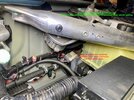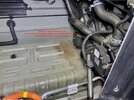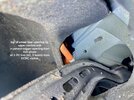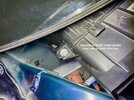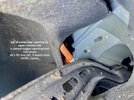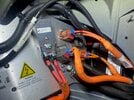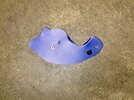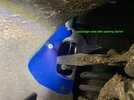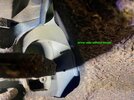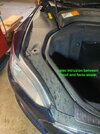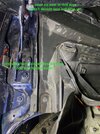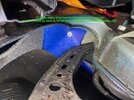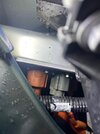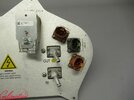Here is some analysis of cowl water leak. Didn't fix yet, just analyzing to understand the problem more completely first. Easy hack is to run sealant in all the seams and gaps and may eventually be the only solution available given the design
- Most obvious problem is rubber ends on 2 bottom corners of the windshield cowl seam has no sealant of any kind. Passenger side in particular is where wiper draws down a lot of the water. Unexplained purpose gap enables addition intrusion.
- Drain path goes forward on the car and dump in an opening in the wheel well. Just to have a hole from the wheel well in under the hood with a rubber flap cover seems undesirable. Most cars don't guide water forward with potential incoming airflow (when car travels forward) The plastic side covers may reduce this in MS. Most car runs water towards a drain in the very corner under the front hood just before the front door opening. Its a natural drain path and any incoming air flow while driving forward aids the path.
- Drain path into open wheel well is a rubber flap secured by plastic clip through a hole. The hole is yet another leak source. Best not to have a hole and just let the flap lay down by gravity (or secure by moulded rubber clip underneath) and top cover flap to maintain downhill grade for water flow into wheel well opening.
- Windshield is rigid and precise. Large hard plastic cowl piece is far from precise and will distort over time. Seam is sealed by a 1mm+ thick rubber surface on the bottom windshield clip. Not possible to expect a tight fit... water will sit in the seam and work to breach it. Most cars will accept natural bigger imprecise gap fill it with thin pliable rubber strip to seal off windshield water runoff from getting under seams.
- Lacking a 2nd cowl. Most cars have a metal shelf cowl below a plastic cowl housing wiper motors and articulating mechanisms. This is a 2nd barrier and guide for runoff water. MS has none.
Probably the only way to fix is the hack of bead of sealant. Doubtful any rubber tape will last long (also need a bevel one anyway to avoid having water sitting on a raised edge) Add rubber sheet under wheel well runoff guide which doesn't extend far enough and will leak before reaching wheelwell.
Next step after fixing this dam is any spray/leak path to DCDC. Might not be possible to prevent moisture entry so perhaps DCDC cover is best that can be done.
- Most obvious problem is rubber ends on 2 bottom corners of the windshield cowl seam has no sealant of any kind. Passenger side in particular is where wiper draws down a lot of the water. Unexplained purpose gap enables addition intrusion.
- Drain path goes forward on the car and dump in an opening in the wheel well. Just to have a hole from the wheel well in under the hood with a rubber flap cover seems undesirable. Most cars don't guide water forward with potential incoming airflow (when car travels forward) The plastic side covers may reduce this in MS. Most car runs water towards a drain in the very corner under the front hood just before the front door opening. Its a natural drain path and any incoming air flow while driving forward aids the path.
- Drain path into open wheel well is a rubber flap secured by plastic clip through a hole. The hole is yet another leak source. Best not to have a hole and just let the flap lay down by gravity (or secure by moulded rubber clip underneath) and top cover flap to maintain downhill grade for water flow into wheel well opening.
- Windshield is rigid and precise. Large hard plastic cowl piece is far from precise and will distort over time. Seam is sealed by a 1mm+ thick rubber surface on the bottom windshield clip. Not possible to expect a tight fit... water will sit in the seam and work to breach it. Most cars will accept natural bigger imprecise gap fill it with thin pliable rubber strip to seal off windshield water runoff from getting under seams.
- Lacking a 2nd cowl. Most cars have a metal shelf cowl below a plastic cowl housing wiper motors and articulating mechanisms. This is a 2nd barrier and guide for runoff water. MS has none.
Probably the only way to fix is the hack of bead of sealant. Doubtful any rubber tape will last long (also need a bevel one anyway to avoid having water sitting on a raised edge) Add rubber sheet under wheel well runoff guide which doesn't extend far enough and will leak before reaching wheelwell.
Next step after fixing this dam is any spray/leak path to DCDC. Might not be possible to prevent moisture entry so perhaps DCDC cover is best that can be done.



